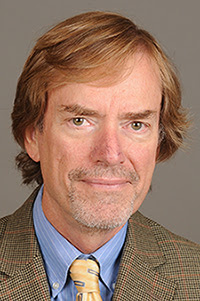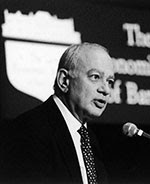The Second International Modern Monetary Theory Conference
The Levy Institute is a cosponsor of the Second International Modern Monetary Theory Conference, which will take place September 28–30 at the New School and will feature Institute scholars L. Randall Wray, Pavlina Tcherneva, Stephanie Kelton, and Mathew Forstater:
Like the first conference, this year will feature contributions from fields as diverse as macroeconomics, law, history, public policy, and corporate finance, with the goal of creating a community of scholars working within the MMT paradigm. This year’s theme, “Public Money, Public Purpose, Public Power,” signals the MMT community’s efforts to build bridges between social justice movements, inspire broad-based participation, and more deeply discuss how our ideas may be concretized politically.
The conference runs from Friday, September 28 through Sunday, September 30. Friday will feature roundtable discussions and keynote addresses from MMT luminaries on the origins of MMT, the process of making MMT “mainstream,” and the relationship between MMT and progressive advocacy for the job guarantee. Saturday will feature workshops facilitated by a range of community leaders and experts seeking to develop and deepen connections between MMT and other fields. Sunday begins with two “town hall” meetings, exploring MMT’s capacity as both a domestic and an international movement. The proceedings will conclude with a plenary session on the strategic and institutional goals of the movement going forward.
To learn more about the Second International MMT Conference or to register, visit their website at mmtconference.org or email [email protected].
Learn more about MMT in these Levy Institute publications:
Functional Finance: A Comparison of the Evolution of the Positions of Hyman Minsky and Abba Lerner
L. Randall WrayThis paper examines the views of Hyman Minsky and Abba Lerner on the functional finance approach to fiscal policy. It argues that the main principles of functional finance were relatively widely held in the immediate postwar period. However, with the rise of the Phillips curve, the return of the Quantity Theory, the development of the notion of a government budget constraint, and accelerating inflation at the end of the 1960s, functional finance fell out of favor. The paper compares and contrasts the evolution of the views of Minsky and Lerner over the postwar period, arguing that Lerner’s transition went further, as he embraced a version of Monetarism that emphasized the use of monetary policy over fiscal policy. Minsky’s views of functional finance became more nuanced, in line with his Institutionalist approach to the economy. However, Minsky never rejected his early beliefs that countercyclical government budgets must play a significant role in stabilizing the economy. Thus, in spite of some claims that Minsky should not be counted as one of the “forefathers” of Modern Money Theory (MMT), this paper argues that it is Minsky, not Lerner, whose work remains essential for the further development of MMT.
Money, Power, and Monetary Regimes
Pavlina R. TchernevaMoney, in this paper, is defined as a power relationship of a specific kind, a stratified social debt relationship, measured in a unit of account determined by some authority. A brief historical examination reveals its evolving nature in the process of social provisioning. Money not only predates markets and real exchange as understood in mainstream economics but also emerges as a social mechanism of distribution, usually by some authority of power (be it an ancient religious authority, a king, a colonial power, a modern nation state, or a monetary union). Money, it can be said, is a “creature of the state” that has played a key role in the transfer of real resources between parties and the distribution of economic surplus.
In modern capitalist economies, the currency is also a simple public monopoly. As long as money has existed, someone has tried to tamper with its value. A history of counterfeiting, as well as that of independence from colonial and economic rule, is another way of telling the history of “money as a creature of the state.” This historical understanding of the origins and nature of money illuminates the economic possibilities under different institutional monetary arrangements in the modern world. We consider the so-called modern “sovereign” and “nonsovereign” monetary regimes (including freely floating currencies, currency pegs, currency boards, dollarized nations, and monetary unions) to examine the available policy space in each case for pursuing domestic policy objectives.
This paper is also available in Spanish.
Modern Money Theory: A Primer on Macroeconomics for Sovereign Monetary Systems, Second Edition
L. Randall WrayIn a completely revised second edition, Senior Scholar L. Randall Wray presents the key principles of Modern Money Theory, exploring macro accounting, monetary and fiscal policy, currency regimes, and exchange rates in developed and developing nations. Wray examines how misunderstandings about the nature of money caused the recent global financial meltdown, and provides fresh ideas about how leaders should approach economic policy. This updated edition also includes new chapters on tax policies and inflation.
Modern Money Theory 101: A Reply to Critics
Éric Tymoigne and L. Randall Wray
This paper examines the views of Hyman Minsky and Abba Lerner on the functional finance approach to fiscal policy. It argues that the main principles of functional finance were relatively widely held in the immediate postwar period. However, with the rise of the Phillips curve, the return of the Quantity Theory, the development of the notion of a government budget constraint, and accelerating inflation at the end of the 1960s, functional finance fell out of favor. The paper compares and contrasts the evolution of the views of Minsky and Lerner over the postwar period, arguing that Lerner’s transition went further, as he embraced a version of Monetarism that emphasized the use of monetary policy over fiscal policy. Minsky’s views of functional finance became more nuanced, in line with his Institutionalist approach to the economy. However, Minsky never rejected his early beliefs that countercyclical government budgets must play a significant role in stabilizing the economy. Thus, in spite of some claims that Minsky should not be counted as one of the “forefathers” of Modern Money Theory (MMT), this paper argues that it is Minsky, not Lerner, whose work remains essential for the further development of MMT.
Other Levy MMT Publications:
Banking, Finance, and Money: A Socioeconomics Approach
L. Randall Wray
Functional Finance: What, Why, and How
Stephanie A. Kelton
Functional Finance and Full Employment: Lessons from Lerner for Today?
Mathew Forstater
(Full) Employment Policy: Theory and Practice
Dimitri B. Papadimitriou











 ShareThis
ShareThis